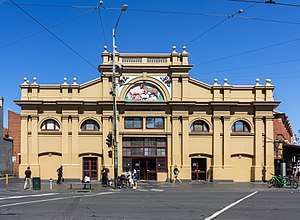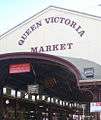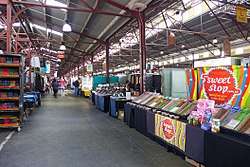Queen Victoria Market
The Queen Victoria Market (also known locally as Vic Market or Queen Vic) is a major landmark in Melbourne, Victoria, Australia, and at around seven hectares (17 acres) is the largest open air market in the Southern Hemisphere.


The Queen Victoria Market is the largest and most intact surviving 19th century market in the city. The Melbourne central business district once hosted three major markets, but two of them, the Eastern Market and Western Market, both opened before the Queen Victoria, and were both closed and demolished in the 1960s. Other historic markets survive in Melbourne, such as the inner suburban Prahran Market and South Melbourne Market, though only Prahran has any early buildings. The Queen Victoria Market is historically, architecturally and socially significant and has been listed on the Victorian Heritage Register. It has become an increasingly important tourist attraction in the city of Melbourne.
History
Queen Victoria Market occupies two city blocks; one rectangular block bounded by Victoria, Peel, Franklin and Elizabeth Streets and one eastern irregular block bounded by Queen, Victoria, Elizabeth and Therry Streets. The market was established in the late 1860s to serve as both a wholesale and retail market for the rapidly growing population of the city of Melbourne. The centrally located Queen Victoria Market replaced a number of smaller markets situated in different parts of the city. The site was developed in stages from 1867 through to 1936 when the site was fully developed. Throughout the twentieth and twenty-first centuries, the market has undergone minor expansions and upgrades. Proposals for more substantial re-developments continue to the present time.[1] The site, now occupied by the Queen Victoria Market complex, has a long and varied history, including a cemetery, an orderly room, a rifle range, a long gone street, a livestock market, and a wholesale fruit and vegetable market.[2]
Before the Market
The Western Market was Melbourne's first official fruit and vegetable market, established a mere 6 years after settlement began. Ultimately a wholesale cased fruit market, it lasted for ninety years taking up the entire block bounded by Market, Collins and Williams Streets and Flinders Lane in the middle of Melbourne's central business district.
The further development and expansion of Melbourne to the east led to the establishment of the Eastern Market. Much more popular than the Western Market, the Eastern Market was heavily frequented by the general public. Its growth over time and public popularity led to the decline of the Western Market.[3]
Much of the land on which the Upper Market and the carpark sits was once part of the Old Melbourne Cemetery, the only official cemetery between 1837 and 1854 when it was officially closed. In this period, 7000 'early settlers' had died in Melbourne, and most buried here, including explorer John Batman). Occasional burials continued until 1917, and in 1920 it was estimated there was a total of 10,000 burials on the site, though the exact number is not known since the cemetery records were destroyed in a fire in 1864.[4] Sheds D, E and F were built on part of the cemetery, originally allocated as Jewish, Aboriginal and Quaker areas, where few burials had taken place, and after the Jewish community were satisfied their area was clear.[4] Between 1920 and 1922, 914 bodies were exhumed from the remainder of the long abandoned site,[5] and re-buried in other cemeteries around Melbourne, notably at the new Fawkner Cemetery which has a Pioneer's section with 220 of the earliest burials and some relocated headstones.[6] In the 1920s, Sheds K-L and M were built on part of the cleared cemetery, and in 1930 stores were built at the Franklin Street end, so there are still anything between 6000 and 9000 burials remaining below these structures and the car park, and any works in that area that may disturb them are a sensitive issue.[7]
Creation of the Lower Market
The Lower Market (Deli Hall, Meat & Fish Hall and H & I Sheds) was originally set aside in 1857 for a fruit and vegetable market due to over-crowding and congestion at the Eastern Market. However, the location was contested due to its proximity to the Old Melbourne Cemetery. It was unpopular with market gardeners who refused to use the space. This resulted in the space becoming a livestock and hay market (the Meat Market Reserve) until 1867 when a substantial brick building (the Meat Hall) was erected on the corner of Elizabeth and Victoria Street. Despite spending a short time as a Wholesale Meat Market, this building eventually became a retail Meat and Fish Market and slaughterhouse.[3]
In the year of its official founding, the Market expanded into wholesale and retail fruit and vegetable trading which prompted the construction of G, H, I & J Sheds. H & I Sheds still stand in their original positions however G Shed was removed to construct the loading bay for the Meat Hall and J Shed later burnt down only to be replaced with a public plaza.
The Elizabeth Street shops were constructed in 1880 following the realignment of Elizabeth Street which also allowed the well-known Meat & Fish Hall façade to be constructed in 1884.
Creation of the Upper Market
The Upper Market - unlike the Lower Market - was not originally reserved as a marketplace. The site had undergone a number of uses including a school and a drill hall but was most famously the site of Melbourne's first cemetery.[8] Construction of A-F Sheds began in 1877 at the Victoria Street end of the Market since this area contained the least used section of the cemetery. By 1930, the entire Upper Market site (including K and L Sheds) had been constructed and extended all the way up to Peel Street.[3]
Between 1929 and 1930 the City of Melbourne constructed 60 brick stores, which were located on the current site of the car park, to house the wholesale agents and merchants. However, this was short lived after allegations of corruption and racketeering caused a Royal Commission (1960) which led to the decision to relocate the Wholesale Market to Footscray in 1969. All that remains today is a single row of these stores along Franklin Street.[3]
Protecting the Market
A 1964 City of Melbourne report advocated for redevelopment of the site as a 1200 space car park, which would have become the largest in the city centre.[9]
The separation of the Wholesale Market from the Retail Market led to a plan to redevelop the Queen Victoria Market site into a trade centre, office and hotel complex in the 1970s.[10] However, public outcry and a green ban prevented this and resulted in the Market being classified by the National Trust.[10][11] The Market site and its buildings were listed on the Historic Buildings Register.[12] The Queen Victoria Market survives today as the largest and most intact of Melbourne's great nineteenth century markets.[3]
Brief timeline
The following timeline is based on a historic survey carried out by an architectural firm, specialising in heritage and conservation:[13]
- 1868 Construction of the market first started
- 1869 Opening of the Meat Hall, initially used as a wholesale market
- 1874 Meat hall commenced operating as a retail market
- 1877 Sheds G, H and I were probably constructed first; served as the fruit and vegetable market
- 1877-1878 Sheds A-E were completed
- 1878 Queen Victoria Market officially opened by Mayor, Cr. John Pigdon
- 1888-89 Shops constructed along Victoria Parade
- 1884 Shops constructed along Elizabeth Street
- 1884 and 1890 Major replanning of the public façades of the Market
- 1917-1923 Council obtained additional land and extended the market westwards and southwards; sheds F, K and L sheds were constructed
- 1922 Sheds D, E and F extended to Peel Street
- 1923 Sheds K and L sheds constructed
- 1926 -28 Dairy Produce Hall and Therry Street substation constructed.
- 1930 The Franklin Street stores constructed
- 1936 Additional sheds M, N and O of very simple form were constructed, completing the whole of the development
- 1977 Sheds A- F, Queen Victoria Market, refurbished, cost $650,000
- 1978 J Shed in Therry Street demolished
- 1979 (March 25) First Sunday Market at the Queen Vic.
- 1980-82 Meat Hall extended, Therry Street Plaza and Northern Plaza constructed.
- 1986 Sheds N and O Sheds demolished and converted to a car park
- 1988 Victoria Square shops opened
- 1998 First Night Market
Gallery
 Entrance to the Meat Hall with the Victoria Street retail row
Entrance to the Meat Hall with the Victoria Street retail row One of the many open-air sheds that comprise the market's central hub
One of the many open-air sheds that comprise the market's central hub Facade of the Meat Hall (detail)
Facade of the Meat Hall (detail) View of the Market sheds
View of the Market sheds
Today




Today, the Market is a major Melbourne tourist destination, adding to its social and cultural significance. Many of the original market structures remain intact, presenting visitors with nineteenth century streetscapes and a working market place. The Meat Hall, constructed in 1869, remains largely intact and is the oldest of the original buildings. The Elizabeth Street facade is predominantly intact in relation to its 1884 construction, while the arched north-west and south-east elevations are substantially intact in relation to their 1869 construction. The retail rows in Elizabeth and Victoria Streets, constructed between 1882 and 1891, are important and architecturally significant buildings, affording visitors the opportunity to shop in an extensive and intact 19th century streetscape.[14]
The Market is open every day of the week except Mondays and Wednesdays. On Wednesday evenings in the summer months, a night market which offers dining, bars, live entertainment and a variety of other stalls. It offers both local and international visitors a variety of fruit and vegetables, meat, poultry and seafood, gourmet and delicatessen foods as well as specialty delicacies.[15] It also has a large non-food related market, selling a diverse range of clothing, shoes, jewellery and handmade arts and crafts.
Expansion and re-development activities have continued through to the present time. In 2003 the market was equipped with solar panels that harness enough energy to power all the market's clients, and provide a surplus.[16] In January 2010, the Herald Sun reported that city planners wanted to transform the market into a "gourmet hub" by introducing upmarket food stalls.[17] Lord Mayor Robert Doyle said he brought up the idea after visiting London's Borough Market, which has a "boutique" feel that could work in Melbourne. In May 2015 the City of Melbourne draft 2015-2016 budget allocated $80.64 million for investment in the Queen Victoria Market. On 12 June 2015 Lord Mayor Robert Doyle and Environment Minister Greg Hunt announced the beginning of the process to place the Market on the UNESCO world heritage site.
The Queen Victoria Market's Twitter account is under the handle of @VicMarket, and it is used to primarily promote events that occur there such as the Melbourne BBQ Festival and Night Markets.[18] The market is also known for the hot doughnut van which has operated for over half a century and become part of local tradition, being known for its jam donuts.[19]
See also
References
- Allom Lovell & Associates [Conservation architects],Queen Victoria Market: Conservation Management Plan, [Report for QVM], 2003
- Queen Victoria Market Conservation Management Plan. Lovell Chen. 2003.
- "Queen Victoria Market". Queen Victoria Market. Archived from the original on 6 June 2017. Retrieved 2 January 2015.
- Old Melbourne Cemetery, Stage 1 Research and Review. Godden Mackay Logan P/L. April 2013.
- "Queen Victoria Market". Victorian Heritage Database. Heritage Victoria. Retrieved 2 November 2017.
- "FAWKNER MEMORIAL PARK". Victorian Heritage Database. Retrieved 2 November 2017.
- Cooper, Mex (11 March 2011). "Bodies under Queen Vic haunt market revamp". The Age. Archived from the original on 7 February 2017. Retrieved 6 February 2017.
- "Old Melbourne Cemetery". School of Historical & Philosophical Studies, The University of Melbourne. Archived from the original on 15 March 2017.
- 'Report on a planning scheme for the Central Business Area of the City of Melbourne'. E.F.Borrie Town Planner. City of Melbourne. 1 October 1964
- Allom Lovell & Associates [Conservation architects],Queen Victoria Market: Conservation Management Plan, [Report for QVM], 2003, p. 2
- Burgmann, Verity and Meredith (1998). Green Bans, Red Union: Environmental Activism and the New South Wales Builders Labourers' Federation. p. 50.
- Allom Lovell & Associates [Conservation architects],Queen Victoria Market: Conservation Management Plan, [Report for QVM], 2003, p. 104
- Allom Lovell & Associates [Conservation architects],Queen Victoria Market: Conservation Management Plan, [Report for QVM], 2003
- Allom Lovell & Associates [Conservation architects],Queen Victoria Market: Conservation Management Plan, [Report for QVM], 2003, pp 96-97
- Besha Rodell (12 June 2017). "Melbourne Haggles Over the Future of Its Most Popular Market". The New York Times. Melbourne. p. D6. Archived from the original on 15 June 2017. Retrieved 16 June 2017.
- Fyfe, Melissa (11 March 2003). "Has the sun set on solar power?". The Age. Melbourne. p. 11. Archived from the original on 14 March 2003. Retrieved 22 July 2009.
- Hastie, David (3 January 2010). "Traders attack boutique market plan". Sunday Herald Sun. p. 26. Archived from the original on 31 December 2012. Retrieved 3 January 2010.
- "Queen Vic Market (@VicMarket) | Twitter". Twitter. Retrieved 6 February 2017.
- "A hot piece of history". The Age. Melbourne: Fairfax. 5 February 2004. Archived from the original on 31 December 2016. Retrieved 22 July 2009.
External links
| Wikimedia Commons has media related to Queen Victoria Market. |